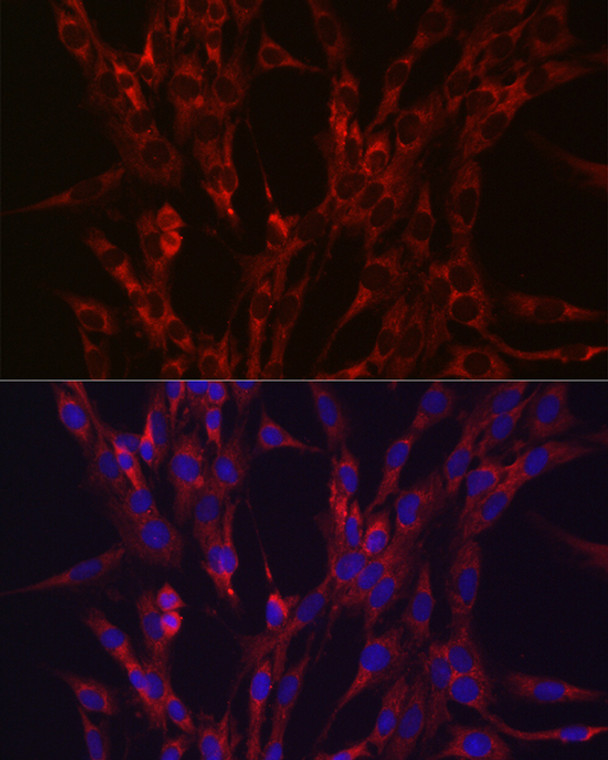| Host: |
Rabbit |
| Applications: |
WB/IF |
| Reactivity: |
Human/Mouse/Rat |
| Note: |
STRICTLY FOR FURTHER SCIENTIFIC RESEARCH USE ONLY (RUO). MUST NOT TO BE USED IN DIAGNOSTIC OR THERAPEUTIC APPLICATIONS. |
| Short Description: |
Rabbit polyclonal antibody anti-HIF3A (1-130) is suitable for use in Western Blot and Immunofluorescence research applications. |
| Clonality: |
Polyclonal |
| Conjugation: |
Unconjugated |
| Isotype: |
IgG |
| Formulation: |
PBS with 0.05% Proclin300, 50% Glycerol, pH7.3. |
| Purification: |
Affinity purification |
| Dilution Range: |
WB 1:500-1:1000IF/ICC 1:50-1:200 |
| Storage Instruction: |
Store at-20°C for up to 1 year from the date of receipt, and avoid repeat freeze-thaw cycles. |
| Gene Symbol: |
HIF3A |
| Gene ID: |
64344 |
| Uniprot ID: |
HIF3A_HUMAN |
| Immunogen Region: |
1-130 |
| Immunogen: |
Recombinant fusion protein containing a sequence corresponding to amino acids 1-130 of human HIF3A (NP_690008.2). |
| Immunogen Sequence: |
MALGLQRARSTTELRKEKSR DAARSRRSQETEVLYQLAHT LPFARGVSAHLDKASIMRLT ISYLRMHRLCAAGEWNQVGA GGEPLDACYLKALEGFVMVL TAEGDMAYLSENVSKHLGLS QLELIGHSIF |
| Tissue Specificity | Expressed in vascular cells (at protein level). Expressed in kidney. Expressed in lung epithelial cells. Expressed in endothelial cells (venous and arterial cells from umbilical cord and aortic endothelial cells) and in vascular smooth muscle cells (aorta). Strongly expressed in the heart, placenta, and skeletal muscle, whereas a weak expression profile was found in the lung, liver, and kidney. Expressed weakly in cell renal cell carcinoma (CC-RCC) compared to normal renal cells. Expression is down-regulated in numerous kidney tumor cells compared to non tumor kidney tissues. Isoform 2 is expressed in heart, placenta, lung, liver, skeletal muscle and pancreas and in numerous cancer cell lines. Isoform 3 and isoform 4 are weakly expressed in heart, placenta, lung, liver, skeletal muscle and pancreas. Isoform 4 is expressed in fetal tissues, such as heart, brain, thymus, lung, liver, skeletal kidney and spleen. Isoform 3 is weakly expressed in fetal tissues, such as liver and kidney. |
| Post Translational Modifications | In normoxia, hydroxylated on Pro-492 in the oxygen-dependent degradation domain (ODD) by prolyl hydroxylase(s) (PHD). The hydroxylated proline promotes interaction with VHL, initiating rapid ubiquitination and subsequent proteasomal degradation. Ubiquitinated.ubiquitination occurs in a VHL- and oxygen-dependent pathway and subsequently targeted for proteasomal degradation. |
| Function | Acts as a transcriptional regulator in adaptive response to low oxygen tension. Acts as a regulator of hypoxia-inducible gene expression. Functions as an inhibitor of angiogenesis in hypoxic cells of the cornea. Plays a role in the development of the cardiorespiratory system. May also be involved in apoptosis. Isoform 2: Attenuates the ability of transcription factor HIF1A to bind to hypoxia-responsive elements (HRE) located within the enhancer/promoter of hypoxia-inducible target genes and hence inhibits HRE-driven transcriptional activation. Also inhibits hypoxia-inducible ARNT-mediated gene expression. Isoform 3: Attenuates the ability of transcription factor HIF1A to bind to hypoxia-responsive elements (HRE) located within the enhancer/promoter of hypoxia-inducible target genes and hence inhibits HRE-driven transcriptional activation. Isoform 4: Attenuates the ability of transcription factor HIF1A and EPAS1/HIF2A to bind to hypoxia-responsive elements (HRE) located within the enhancer/promoter of hypoxia-inducible target genes and hence inhibits HRE-driven transcriptional activation. May act as a tumor suppressor and inhibits malignant cell transformation. Isoform 5: Attenuates the ability of transcription factor HIF1A to bind to hypoxia-responsive elements (HRE) located within the enhancer/promoter of hypoxia-inducible target genes and hence inhibits HRE-driven transcriptional activation. |
| Protein Name | Hypoxia-Inducible Factor 3-AlphaHif-3-AlphaHif3-AlphaBasic-Helix-Loop-Helix-Pas Protein Mop7Class E Basic Helix-Loop-Helix Protein 17Bhlhe17Hif3-Alpha-1Inhibitory Pas Domain ProteinIpasMember Of Pas Protein 7Pas Domain-Containing Protein 7 |
| Database Links | Reactome: R-HSA-1234158 Q9Y2N7-1Reactome: R-HSA-1234176Reactome: R-HSA-452723Reactome: R-HSA-8951664 |
| Cellular Localisation | NucleusCytoplasmNucleus SpeckleMitochondrionIn The Nuclei Of All Periportal And Perivenous HepatocytesIn The Distal Perivenous ZoneDetected In The Cytoplasm Of The HepatocytesShuttles Between The Nucleus And The Cytoplasm In A Crm1-Dependent MannerColocalizes With Bad In The CytoplasmColocalizes With Epas1 And Hif1a In The Nucleus And SpecklesLocalized In The Cytoplasm And Nuclei Under NormoxiaBut Increased In The Nucleus Under Hypoxic ConditionsColocalized With Hif1a In Kidney Tumors |
| Alternative Antibody Names | Anti-Hypoxia-Inducible Factor 3-Alpha antibodyAnti-Hif-3-Alpha antibodyAnti-Hif3-Alpha antibodyAnti-Basic-Helix-Loop-Helix-Pas Protein Mop7 antibodyAnti-Class E Basic Helix-Loop-Helix Protein 17 antibodyAnti-Bhlhe17 antibodyAnti-Hif3-Alpha-1 antibodyAnti-Inhibitory Pas Domain Protein antibodyAnti-Ipas antibodyAnti-Member Of Pas Protein 7 antibodyAnti-Pas Domain-Containing Protein 7 antibodyAnti-HIF3A antibodyAnti-BHLHE17 antibodyAnti-MOP7 antibodyAnti-PASD7 antibody |
Information sourced from Uniprot.org
12 months for antibodies. 6 months for ELISA Kits. Please see website T&Cs for further guidance








